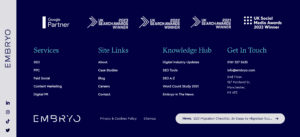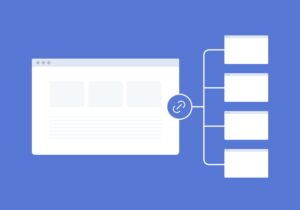
Internal Linking: Best Practices

Internal linking is arguably one of the most important aspects of SEO. Search engines rely on a good internal linking structure to crawl websites effectively. Essentially, internal linking connects web pages to help crawl bots navigate and index content.
Not only do internal links also pass authority from page to page, helping Google understand the importance of each page. Moreover, links help your users browse your website and find the content they’re looking for.
As an SEO professional, ensuring in-text links are properly placed within content is imperative. Without links, search engines may struggle to find and rank your content.
In this guide, we’ll explore the ins and outs of linking, from auditing links to implementation.
Let’s jump into linking!
What are internal links and anchor text?
Internal links are hyperlinks with the same source and target domains, they lead to different sections of the same website. External links take you to a different website, but internal links keep you on the same. The action of adding links to a page falls under technical SEO, this involves adding and monitoring the linking structure for optimisation.
Internal links come in different types:
NAVIGATION LINKS: These are the most popular internal links and help structure your website and guide the reader through the content. In addition, every page of your website has navigation links.

CONTEXTUAL LINKS: Links within the content of a page that direct users to relevant pages.
IMAGE LINKS: Images can also be used as links. Button images, charts, and infographics are examples of this. This link can benefit readers if there is a page that would assist someone who wants additional information about that image.
FOOTER LINKS: Footer links, placed at the bottom of your page, are used to improve the usability of your website. A site’s footer often contains social media widgets, contact information, and an internal search tool for your website.

CTA LINKS: CTA links are usually spread throughout content pieces directing the user to complete an action such as “get a quote” and “contact us”.
Anchor text is the visible, clickable text of a link. It usually appears in a different colour than the surrounding text and is often underlined. For example, this content contains anchor text such as ‘SEO audit’. Adding this contextual anchor text tells the reader what to expect if they click on the link.
Getting your anchor text right increases the chance of someone clicking on your link, and helps search engines by giving them context.
Why do internal links matter?
USER EXPERIENCE: Internal links play a central role in building that online experience. They offer your audience the ability to dig deeper and inform themselves more about a specific topic of interest.
IMPROVED CRAWLABILITY: Search engines use internal links to discover and index new pages on your website. When you link to new or less visible pages, it ensures that these pages are crawled and included in search engine results.
PAGE AUTHORITY: Internal links help to distribute the authority and ranking power of your website’s pages across the site. When you link from high-authority pages to others, you pass some of that authority to the linked pages, helping them rank better in search results.
LOWERING PAGE DEPTH: A well-structured internal linking system can reduce the number of clicks required for users to access a specific page. This reduces the “click depth” and makes content more accessible.
MINIMISING ORPHAN PAGES: Orphaned pages are those that aren’t linked to from any other page on your site. Internal linking reduces the chances of pages becoming orphaned, ensuring that all valuable content can be easily accessed by users and search engines.
PAGE HIERARCHY & STRUCTURE: By strategically linking to relevant parent or category pages, you can establish a clear hierarchy of your website’s content. This makes it easier for both users and search engines to understand the organisation of your site.
Types of anchor text and their uses
Anchor text comes in many forms. Some of the following practices are less favoured in the SEO world, whilst others may only be suitable in certain situations.
BRANDED: This refers to a brand name used as the anchor text, without any additional words. Branded anchor text works well if you’re citing a source or linking directly to a website.
BRAND + KEYWORD: This type of anchor text includes your brand name (or branded phrase) plus an additional keyword or some contextual information. This is a tactic that our Digital PR team often employs to increase brand awareness.
EXACT MATCH: Exact match anchor text includes the exact keyword the page it is linking to is targeting.
PARTIAL MATCH KEYWORDS: Partial match anchor text includes a variation of the keyword the linked-to page targets.
RELATED KEYWORDS: Related keyword anchor text is similar to partial-match anchor text, but it doesn’t include the actual keyword.
NAKED LINK: “Naked” anchor text is when the link’s URL is used as the anchor text.
GENERIC: Generic anchor text doesn’t include any keywords or points of reference. Users will need to read the surrounding text to determine what it’s about. Common example is “click here”.
At Embryo, we mainly focus on branded, exact match and partial match keywords:
Partial keyword example:
- ‘Get the best deal on pet food‘ – ‘pet food’ is the target keyword
- ‘Shop our range of popular gift baskets‘ – ‘gift baskets’ is the target keyword
Exact match keyword example:
- ‘Get the best deal on pet food‘- ‘pet food’ is the target keyword
- ‘Shop our popular range of gift baskets‘ – ‘gift baskets’ is the target keyword
Take note that Google may view an excess of exact match anchor text as a red flag.
How to optimise internal links correctly
Modern SEO, as we all know, has evolved quite drastically over the past few years. It is no longer acceptable to stuff content with links and keywords. The best approach is to be natural, useful and mindful of the user and their experience.
When it comes to optimising your in-text links and ensuring they’re search-engine friendly, there are few tips you should keep in mind.
Think of your anchor text as the front cover to the webpage that opens up to your readers. Those readers expect the cover to accurately reflect the book. As with anchor text, it should be relevant and leave the user with no surprises. For example, you wouldn’t use ‘page speed optimisation’ as the anchor text for a link to an internal linking guide.
Here are a few more tips:
- Whilst there are no set length guidelines for anchor text, it’s best to keep it as concise as possible. We recommend keeping the anchor text to a maximum length of 5-7 words.
- As a reminder, Google can view an excess of exact match anchor text negatively.
- Do not use query string URLs as internal links, e.g. https://embryo.com/search?type=article%2Cpage%2Cproduct&q=elf*+bar*
- For best results, use a mix of different anchor text types. This will sound much more natural.
- When coming up with anchor text, ask yourself two questions:
- What is the most succinct but descriptive way to describe the linked page?
- Would users expect to land on the linked page after clicking this anchor text?
FAQs
Answered by James Welch
Is there an optimal number of links per 100 words?
1. Google has never disclosed that there is an optimal number of links per word count. Successful websites exist on both ends of the spectrum for a number of internal links. Wikipedia is one of the most powerful sites on the web, so following by example based on their number of internal links is likely to be beneficial.
Do crawlers navigate all of the internal links?
Crawlers all have different codes, which have not been disclosed by Google. Research has proven that internal links which are not over-complex, in content with clean and simple HTML, should be able to be crawled and indexed by Google.
Are too many internal links bad for SEO?
This isn’t a common SEO problem. However a website with a very large ‘mega menu’ usually suffers as the majority of the crawl budget goes to this first.
Is internal linking an automatic or manual process?
Internal linking usually has the best results when done manually, as the element of human understanding and intent is what makes the links so effective. There will be tools which can do this for you however this would take away any ‘helpful’ element for the user.
Deeper Insights
If you’re looking for more guidance on SEO best practices, keep reading our guides and blogs.
